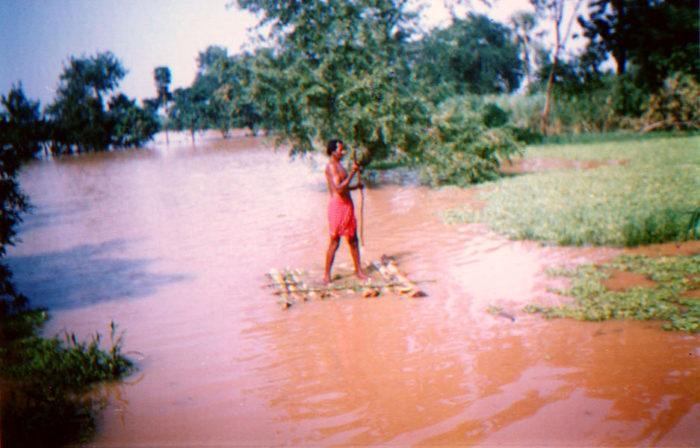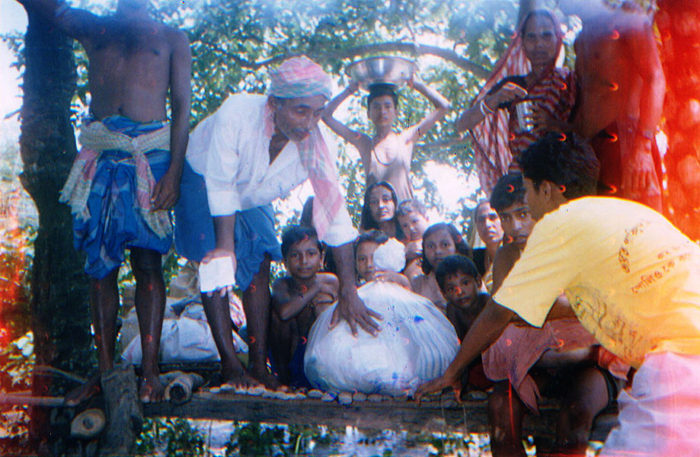Flood in Nabadwip
The flood of 2000 broke all its past records in terms of severity and scale of devastation. SPADE had initiated its field level activities from Nabadwip in the District of Nadia as a consequence of a devastating flood in 2000. Nabadwip rural and urban areas were submerged under a record 11 feet of water. More than 70% of Nabadwip’s population was stranded. Huts were washed away and the homeless were moved to temporary shelters like school buildings. 18 people lost their lives in Nabadwip and about 4,915 looms have been affected by the rain. The whole area was waterlogged. Vidyasagar College in Nabadwip was listed as one of the higher education centers that were badly damaged.
During this period, SPADE, with active support of OXFAM came forward to participate in the relief distribution activities among the distressed villagers in Mahishura GP of Nabadwip. SPADE personnel stayed there for few days to perform the assigned tasks and thus a rapport was built with the flood victims. Some comments of those victims were like “…you will return back to Calcutta after your job is over, but we shall be right here with the same destiny of suffering and hardship due to flood year after year…” really initiated some serious thoughts regarding doing something which would create a sustainable impact on these people. This line of thinking actually gave birth to the philosophy of community participation and involvement in the whole gamut of flood preparedness and thus to minimize the flood damages as far as practicable. So, in the process, the Project, Community Based Disaster Preparedness (CBDP) took shape with the other Inter Agency Group partners.
What makes a disaster?
A disaster is a severe disruption to a community’s survival and livelihood systems, resulting from people’s vulnerability to hazard impacts and involving loss of life and/or property on a scale which overwhelms their capacity to cope unaided.
This means that disasters – even so-called ‘natural disasters’ – are not exogenous and uncontrollable events, temporarily departing from normality, though they are often seen as such. Disasters can be reduced, and in some instances even prevented, by supporting people’s ability to resist hazard impacts.
Vulnerability and poverty
Vulnerability results from people’s exposure to hazards and their susceptibility to hazard impacts. It reflects social, economic, political, psychological and environmental variables, shaped by dynamic pressures (such as urbanisation) that are linked to the national and international political economy.
The converse of vulnerability is capacity to anticipate, cope with, resist and recover from hazard impacts. People’s capacities can be realised through collective action within a favourable institutional environment (local, national and international) to establish societal resilience.
Disasters & Losses – Global picture
According to the United Nations, over the past twenty years disasters from natural hazards have affected 4.4 billion people, claimed 1.3 million lives and caused $2 trillion in economic losses. For the first time, disaster losses globally have topped $100bn for three consecutive years (2010–2012), far outstripping humanitarian aid.
Whilst all countries suffer disasters, they have the greatest impact on poor countries. 86 per cent of deaths from flooding occur in low or low-middle income countries, compared with ten per cent in upper middle and four per cent in high income countries.
Disaster Risk Reduction, Governance & Mainstreaming – UNDP’s view
Natural hazards on their own do not result in disaster. Rather, it is the vulnerability of populations in countries that has a direct bearing on levels of disaster.
Mainstreaming of DRR is a governance process enabling the systematic integration of DRR concerns into all relevant development spheres.
DRR governance and mainstreaming interventions have become an integral part of the majority of UNDP DRR programmes and projects. Activities implemented by UNDP include:
Supporting DRR policy, legal and regulatory framework development and reform Policies, laws and regulations provide the foundation upon which strategies can be built to integrate risk reduction into development practice. UNDP provides technical assistance for the establishment of policy, legal and regulatory frameworks; the enforcement and incentive/disincentive procedures based on DRR legislation and policy; the preparation of national and local action plans to mainstream decentralized DRR into the development process; and the review, revision and updating process established for DRR policy, legal and regulatory framework improvement.
Integrating decentralized DRR into local-level development
Some DRR tasks are best centralized, and others can be devolved to the local level. Participation, monitoring and mediation are best undertaken at the local level and in this way decentralization can – depending on the context – effectively support DRR objectives. UNDP provides technical support for the integration of DRR into the national decentralization framework; public awareness campaigns that are specific to local needs and are locally owned or managed; and the preparation of detailed and costed proposals to extend the mandate and coverage of local disaster information centres.
Conducting DRR analysis
Effective capacity development, advocacy and programming require thorough analysis. UNDP supports diverse analyses, such as sectoral policy papers on a country’s existing disaster-related laws (and suggested revisions thereof); disaster risk management financing analysis, covering public sector spending for DRR, relief and response; and assessment for identifying key gaps in DRR capacity, which provides the basis for incorporating relevant DRR activities into budgeted projects of development plans at the appropriate level.
DRR advocacy, awareness and education
Public awareness and advocacy activities are central to UNDP’s DRR work. With its national and local partners, UNDP supports the organization of seminars with parliamentarians, media and civil society about allocating funds for DRR and operationalizing local disaster management agencies; the establishment of mechanisms to integrate training sessions on DRR as part of official training programmes for senior and middle-level officials of national and provincial governments and agencies; and the integration of DRR knowledge within existing primary and secondary educational programmes like hazard-based media programmes and private sector disaster risk public awareness programmes.







